A gimbal stabilizer is one of the most essential pieces of supporting equipment for DSLR cameras and should be regarded as such. A quality gimbal will expand the range of your camera movements and enable you to capture steady footage, regardless of the camera you use.
Therefore, selecting the right gimbal for your DSLR camera is a task that should be approached with adequate information. I believe the best gimbal for DSLR is the DJI Ronin-SC due to its exceptional payload capacity and stability.
I have also tested various other models and created this guide to assist you in selecting the right one.
Best Gimbal for DSLR
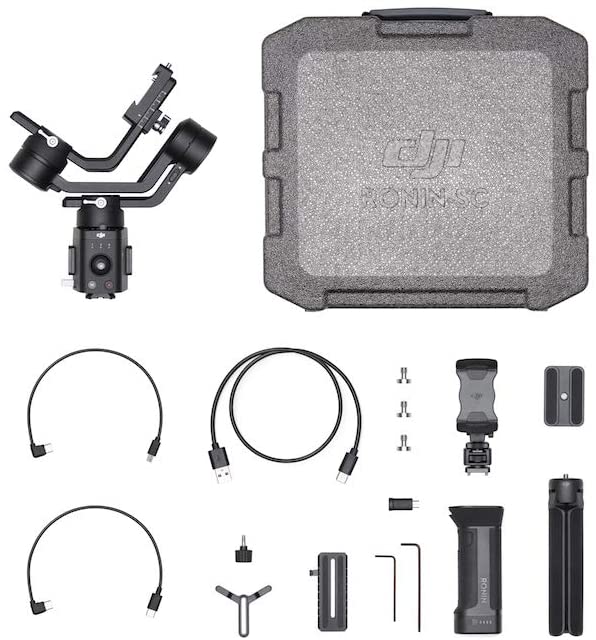 | Top Choice DJI Ronin-SC
| |
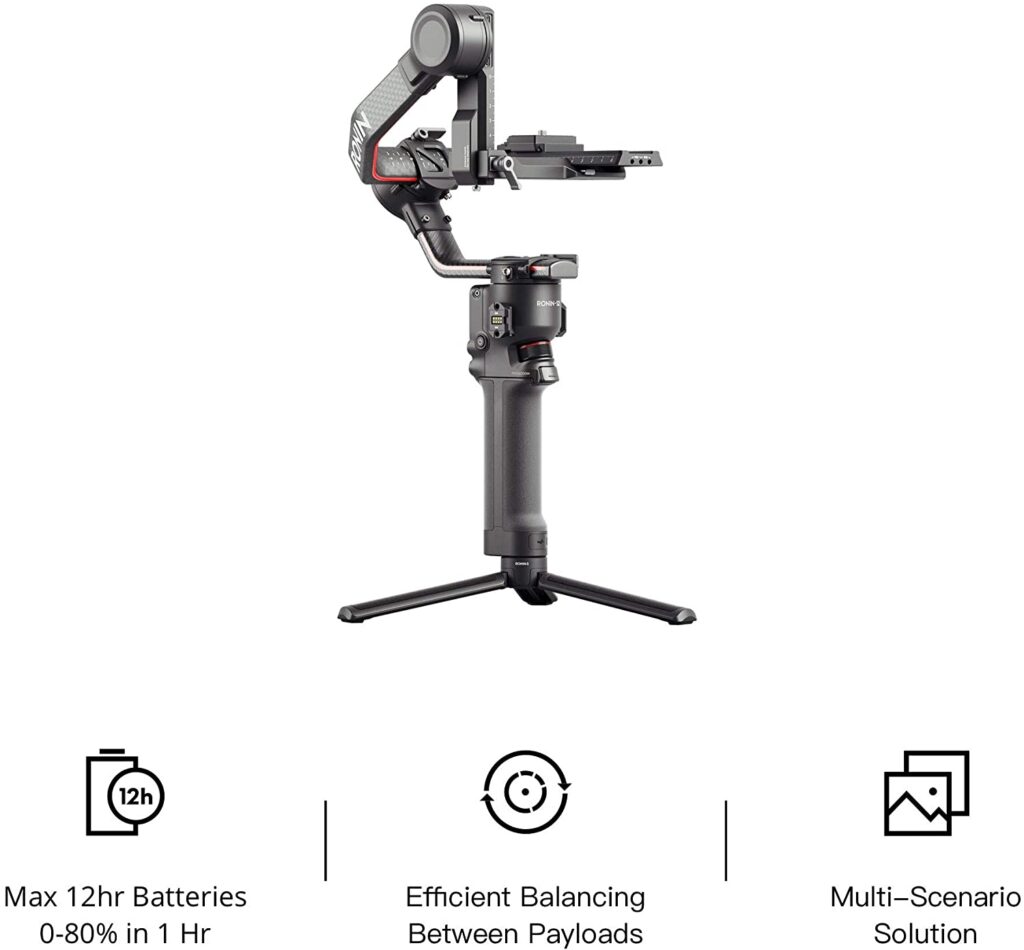 | DJI RS 2
| |
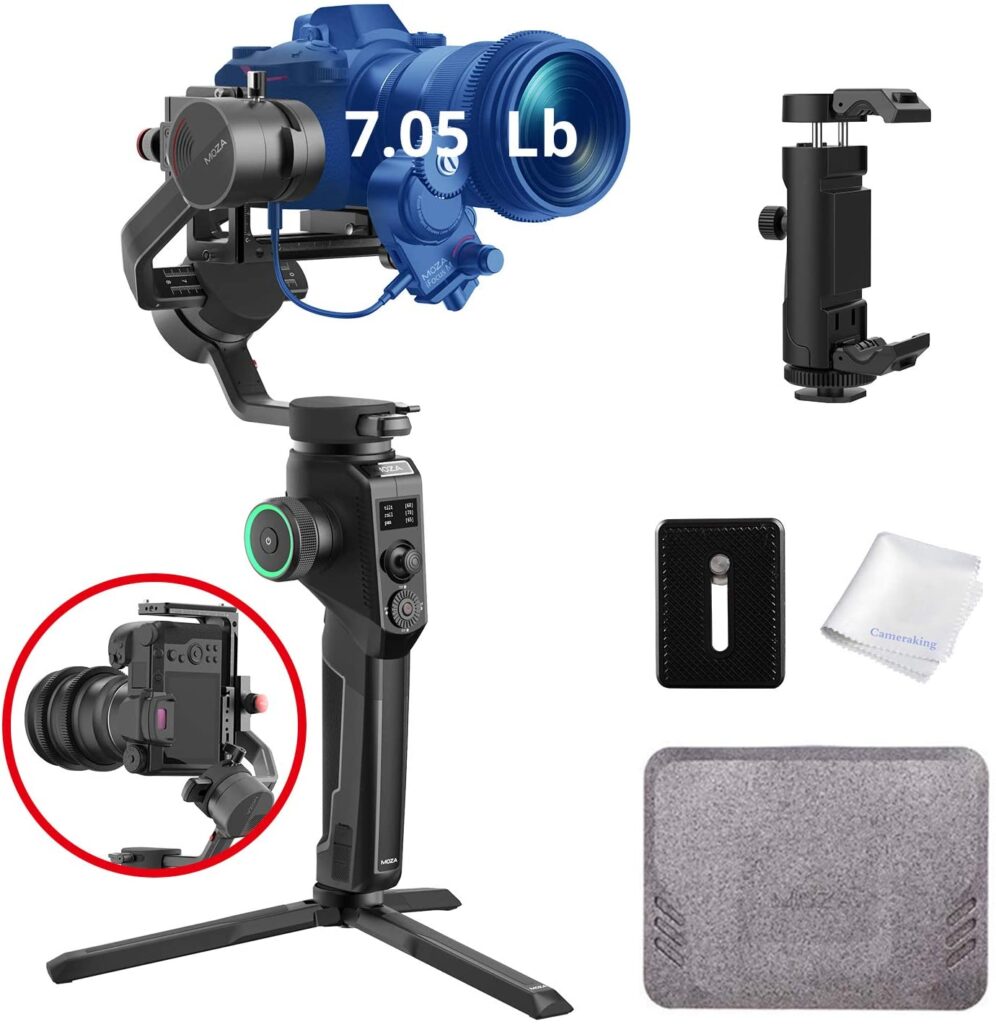 | MOZA Aircross 2 Gimbal
|
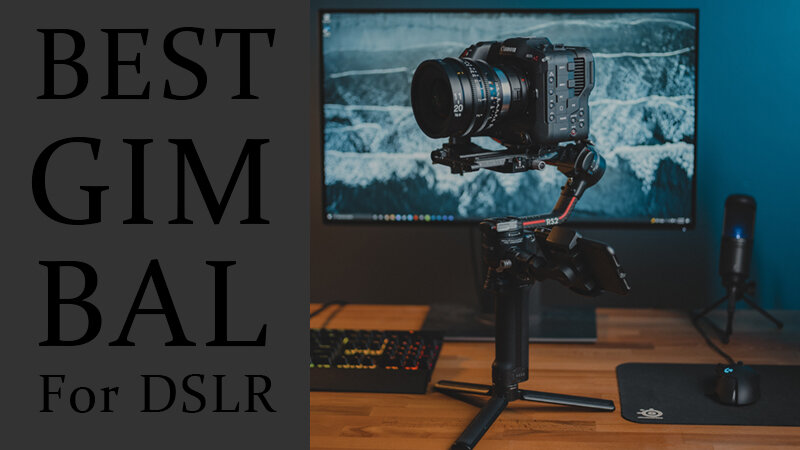
I considered several factors when selecting the gimbal stabilizers for this list, including the number of axes, the distinction between mounted and handheld gimbal stabilizers, camera compatibility, and battery life.
Every gimbal was thoroughly tested, ensuring that you can be confident these are among the best DSLR gimbal stabilizer options currently available on the market.
Table of Contents
1. DJI Ronin-SC
Best Overall
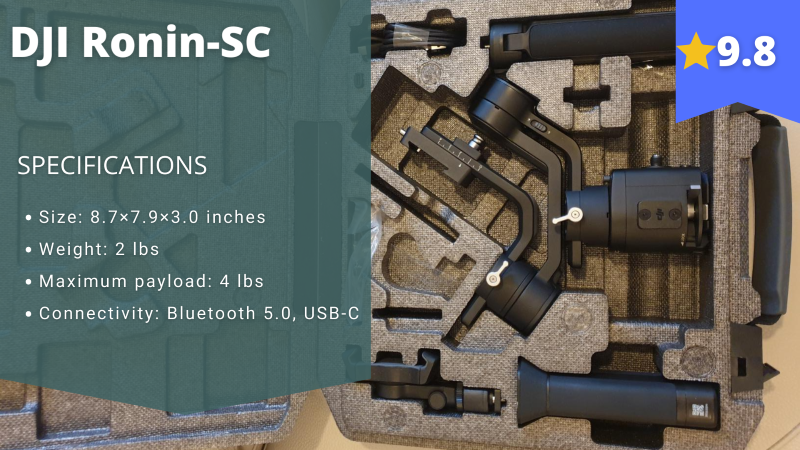
Stefan’s Take:
I have tested DJI Ronin-SC with several DSLR and mirrorless cameras and was amazed by its performance, especially with DSLRs.
The gimbal is lightweight and foldable yet quite stable and ideal for getting clear videos that won’t make your viewers dizzy.
Moreover, I liked the three shooting modes, wireless control and phone tracking, as these features add the most to its practicality.
| Payload | 10 |
|---|---|
| Number of Axis | 10 |
| Remote Control | 9 |
| Battery Life | 10 |
This camera gimbal from DJI has several features that distinguish it from other products in its category.
First of all, this device is extremely lightweight and compact, enabling you to use it effortlessly while on the move. This quality makes it essential for anyone aiming to capture action scenes or simply utilize the camera stabilizer on uneven terrains, such as in the mountains.
Furthermore, the automated Ronin app assists this camera stabilizer in achieving more precise results while in motion, ensuring the camera remains steady and preventing shaking.
Another great feature of this gimbal, which sets it apart from most other DSLR camera stabilizers, is that a significant portion of its motion-sensing, lens stabilization, and other capabilities are automated.
Additionally, this gimbal is easy to handle, as all of its buttons are easily accessible. While it is designed for action cameras, it is also compatible with nearly any other type of camera, which highlights another excellent feature: compatibility.
Regarding compatibility, it’s important to note that the DJI Ronin App requires a minimum of iOS 11.0 or Android 7.0. Therefore, ensure that your smartphone is operating on the appropriate system.
That being said, the gimbal is compatible with a wide range of cameras from various leading brands, including Canon, Fujifilm, and others. This, along with its smartphone app and compatibility with action cameras, makes it an excellent choice for anyone seeking a high-quality gimbal.
Pros
- Very lightweight and easy to use
- Comes with an excellent app
- Very wide compatibility range
Cons
- Has no focus wheel
2. DJI RS 2
Gimbal with the highest payload
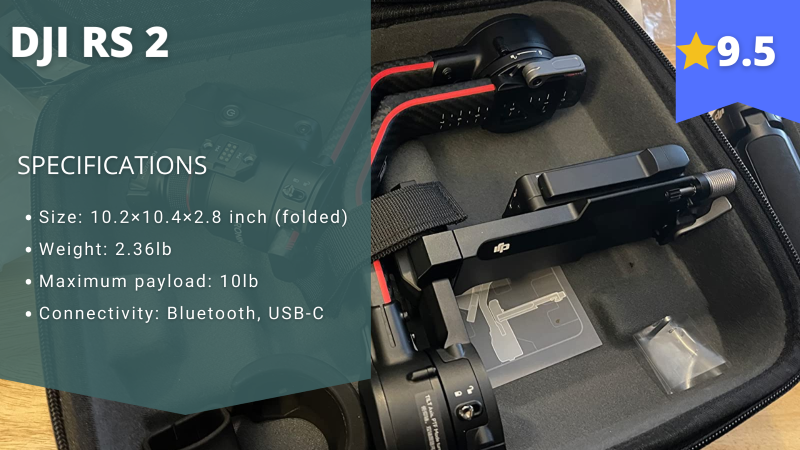
Stefan’s Take:
What stood out the most about DJI RS 2 was the incredible payload of 10 lbs – I didn’t have to worry a bit about which camera I could use it with since I knew that it would easily support even the heaviest ones.
Surprisingly, it was lightweight, and I liked the LCD screen to access all controls. It was relatively easy to manoeuvre and worth every penny.
| Payload | 10 |
|---|---|
| Number of Axis | 10 |
| Remote Control | 9 |
| Battery Life | 9 |
The first thing you will notice upon purchasing this excellent 3-axis gimbal stabilizer is its impressive payload capacity. At 10 lbs, it can effortlessly support nearly any camera and, in fact, boasts some of the highest payloads in its category.
What is surprising yet very welcome, however, is that its weight is only 2.3 lbs, making it nearly as lightweight as many gimbals with a significantly lower carrying capacity.
This is mainly due to the material used in the gimbal’s construction. Carbon fiber is not only incredibly durable but also significantly lighter than any metal, making it the optimal choice for a large 3-axis gimbal like this one.
The next noteworthy feature of this equipment is its LCD touchscreen, which provides immediate access to the powerful RoninApp, enabling you to control your gimbal and camera without needing a smartphone.
Additionally, the mounting plate is compatible with both Arca-Swiss and Manfrotto mounting options, providing you with greater flexibility when selecting the camera to use with this gimbal.
Overall, this is an excellent stabilizer, featuring many useful attributes along with outstanding durability and payload capacity. I would recommend it to anyone in need of a multi-purpose gimbal.
Pros
- Excellent touch screen
- Incredible 10 lbs maximum payload
- Durable carbon fibre construction
Cons
- Significantly more expensive than many alternatives
3. MOZA Aircross 2 Gimbal
Gimbal with the Best Battery Life
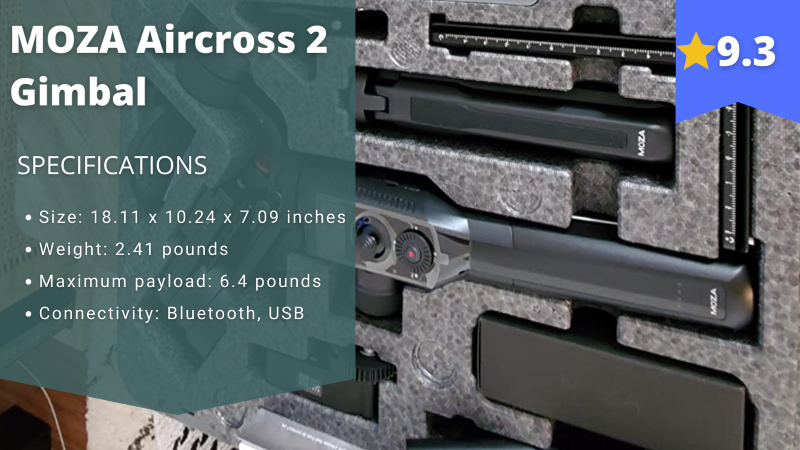
Stefan’s Take:
I liked plenty of MOZA Aircross 2 features: stability, quality materials, lightweight, foldable design, and built-in screen for controlling.
But what caught my eye was the battery life. I was filming for several hours and got worried about the battery draining soon. However, even after a long day of recording and testing the gimbal, it still had enough battery for a few more hours.
| Payload | 9 |
|---|---|
| Number of Axis | 9 |
| Remote Control | 9 |
| Battery Life | 10 |
This handheld camera gimbal is an excellent choice for any DSLR or mirrorless cameras, provided they do not exceed the maximum payload.
The gimbal is constructed from a highly durable magnesium alloy, enabling it to provide stability comparable to much heavier gimbals, all while weighing just over a kilogram. This design allows for the creation of cinematic-quality videos using only one hand.
Additionally, its 3000mAh battery is more than sufficient to provide the gimbal with a decent battery life of up to 12 hours. It can also be used as a power source for your DSLR camera and other equipment.
The complete automation of the rotation, speed, and angle at which the gimbal positions your DSLR or mirrorless camera for streaming provides you with a significantly greater range of movement and customization options, as you won’t need to manipulate the joystick while filming.
Additionally, this device includes mimic motion control, enabling you to operate it remotely using your smartphone.
Finally, the gimbal stabilizer includes an excellent smart wheel and OLED screen, both of which help you fine-tune the camera parameters, enabling you to capture much smoother footage.
Pros
- Excellent OLED screen
- Easy image stabilization
- Light enough to hold in one hand
Cons
- Expensive
4. Zhi Yun Weebill S
Ideal for Streamers on the Move
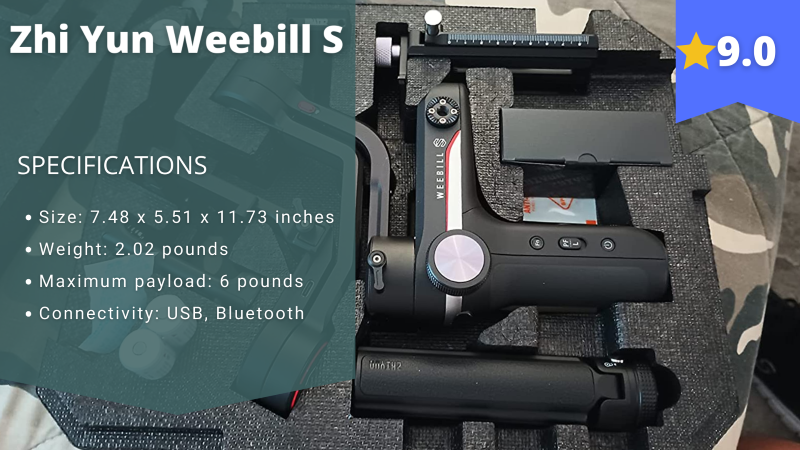
Stefan’s Take:
I think this gimbal would suit the best somebody who is frequently on the go. The design is foldable and lightweight, so you won’t feel dragged down by the extra equipment you have to carry around.
Also, Zhi Yun created a gimbal with improved stabilization through a unique axis-locking mechanism. This makes finding the right position for filming and precision much easier.
| Payload | 9 |
|---|---|
| Number of Axis | 9 |
| Remote Control | 9 |
| Battery Life | 9 |
This gimbal stabilizer functions as both a DSLR camera gimbal and a mirrorless camera gimbal stabilizer, accommodating a wide range of cameras and lenses.
Highly precise and equipped with excellent motors, the gimbal is surprisingly lightweight, weighing no more than 900 grams (battery not included).
The most significant advantage of this gimbal is its compact size and the ability to fold in on itself for easy transport. As a result, the Weebil S is likely the best DSLR gimbal in this price range for those who frequently shoot on the move.
Additionally, this makes the Weebill 3-axis handheld gimbal stabilizer an exceptionally versatile piece of equipment, allowing for adjustments on the move.
This compact gimbal also includes an individual axis locking mechanism for each arm, enabling the adjustment of each axis separately for greater precision.
The OLED screen enables you to instantly change gimbal settings, which are then automatically implemented. Furthermore, many functions can also be manipulated and adjusted using the handle, allowing for even quicker modifications.
Overall, I consider this gimbal to be one of the best products I have had the opportunity to test. It is highly practical, boasts a long battery life of 14 hours, and is entirely handheld, making it fully deserving of its place on this list.
Pros
- Very lightweight and compact
- OLED screen allows for easy control of the camera’s movements
- The interchangeable lithium-ion batteries
Cons
- It doesn’t support large cinema cameras
5. DJI RSC 2
Excellent Compatibility
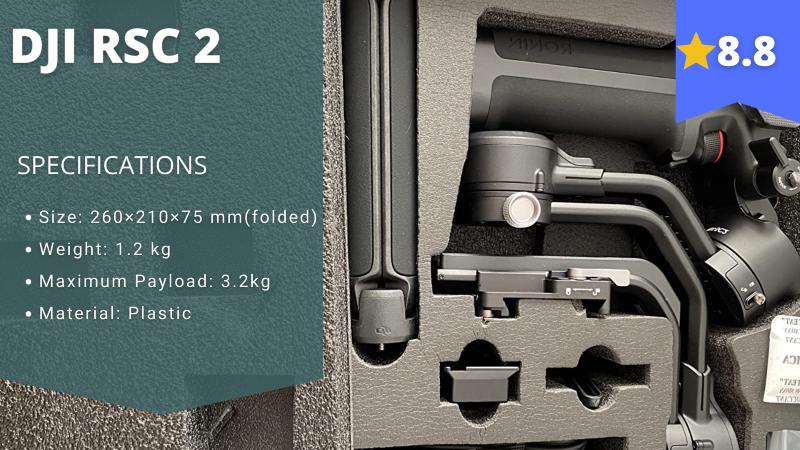
Stefan’s Take:
I tested DJI RSC 2 with my Canon 90D (a quite heavy DSLR camera), and it didn’t feel too heavy to use. The manoeuvring was a bit tricky at first, and it does require a learning curve to use it properly and get the most out of it.
The battery life is outstanding, and it features an LCD screen. However, for my taste, it was too small, and I didn’t particularly appreciate that it was mostly made of plastic and easy to damage.
| Payload | 9 |
|---|---|
| Number of Axis | 9 |
| Remote Control | 9 |
| Battery Life | 8 |
This excellent gimbal stabilizer is fully foldable, making it highly sought after for its ease of transport.
However, that barely scratches the surface of the quality and versatility this product offers. Firstly, it has a substantial payload capacity of 6.6 lbs and incorporates Titan Stabilization, an algorithm designed to ensure the footage quality remains as consistent as possible.
The gimbal also includes a 1-inch OLED screen, which, although informative, is regrettably too small for easy and comfortable use.
Much better, however, is the 14-hour battery life and the fast recharge time, which enable you to be highly mobile with your gimbal and ensure smooth image capture even during all-day shoots.
What I disliked about this gimbal, however, was the material it is made from. Although its plastic frame is surprisingly lightweight and durable, it is significantly more prone to wear and damage than a metal or carbon fiber frame would be.
Ultimately, this is one of the better camera gimbals currently available, but it is not exceptional. It provides a solid mid-range option for those who do not want to invest too much money in purchasing one.
Pros
- Very small when folded
- Pretty good quality
- Battery life is excellent
Cons
- The OLED screen is too small
6. Zhiyun Crane 3S
Excellent gimbal for heavier cameras
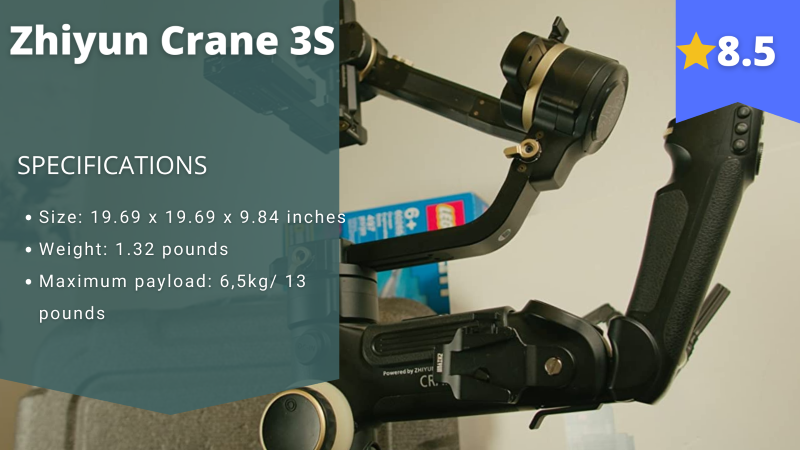
Stefan’s Take:
While this gimbal wasn’t, particularly what I needed, it has plenty of positive features. The stabilizer is rock-solid and easy to assemble and use. It took me 10 minutes to set it up, mount my camera, and start recording.
The payload and battery life are also great, and the gimbal performs quite well in high-speed motion. However, I didn’t like how heavy it was, and considering the price, I wasn’t too impressed.
| Payload | 9 |
|---|---|
| Number of Axis | 9 |
| Remote Control | 8 |
| Battery Life | 8 |
This high-quality gimbal stabilizer is designed to support large cinema cameras and camcorders, but it can also accommodate many smaller DSLR cameras if necessary.
It has a maximum payload of 6.5 kg, which is more than sufficient for most cine cameras, and features large motors that facilitate the easy movement of these larger and heavier recording devices.
Additionally, the gimbal is remarkably stable and can be utilized in high-speed motion or extremely windy conditions without any impact from these environmental factors on the robustly constructed Zhiyun crane.
Furthermore, the gimbal includes a removable extension that enables it to accommodate various cameras, regardless of their size, which is quite rare in the gimbal market today.
Finally, the battery life of the Zhiyun Crane 3S is impressive. With 12 hours of usage, it is more than sufficient for most recording sessions. If additional power is needed, the DC-In port facilitates easy charging, even while on the move, as long as you have a compatible power source of up to 25.2V.
Overall, this is a very good gimbal, particularly if you frequently use large DSLR cameras or cine cameras. Otherwise, a smaller camera stabilizer can perform just as effectively.
Pros
- Almost unmatched weight capacity for large cameras
- Small OLED screen is very clear
- Relatively good battery life and easy to recharge
Cons
- Extremely expensive
7. Flycam Redking Camera Stabilizer
Excellent budget choice
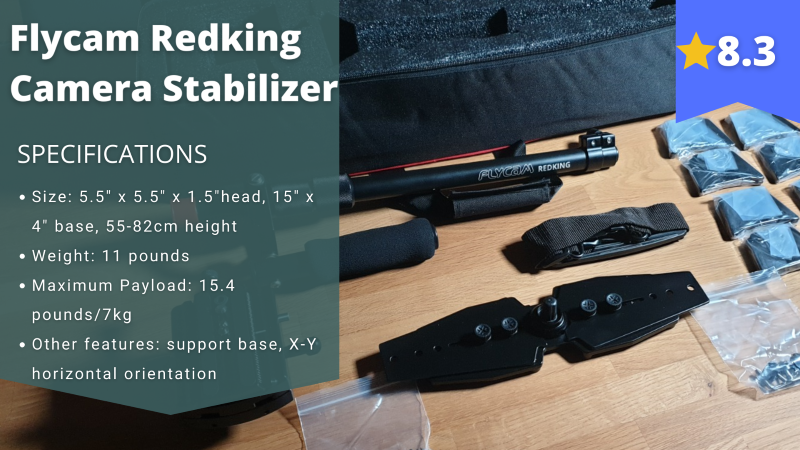
Stefan’s Take:
I have to say that figuring out how to use this gimbal took some time. While it has quite a simple construction, it isn’t the best for outdoor shots and uneven ground.
Also, it’s one of the heavier gimbals, but you get good stability and a great payload. Thanks to quality materials, it’s resistant to wear and will last you for years to come.
| Payload | 9 |
|---|---|
| Number of Axis | 8 |
| Remote Control | 8 |
| Battery Life | 8 |
This unique gimbal stabilizer is constructed from a highly durable aluminum alloy, providing excellent resistance to wear and damage while remaining extremely lightweight and portable.
Additionally, the 3-axis frame enables 360-degree orientation of your choice, while the X-Y adjustments allow for precise manipulation of your camera’s horizontal position.
Furthermore, the platform of this webcam is highly stable and includes a set of weights that make it slightly heavier, ensuring that it stays in place even during windy conditions, for instance.
Unfortunately, the nature of this platform requires you to place it on flat and solid ground, as it has a wide base that makes it unsuitable for uneven terrain.
The handle provides a simple method for controlling the camera stabilizer, and the maximum payload is impressively high at 7kg or 15.4 lbs, surpassing all the gimbals discussed so far.
While this feature makes it an excellent choice for large cinema cameras and camcorders, it also makes it somewhat challenging to use with smaller models.
One significant disadvantage of this camera stabilizer is the lack of motors, which renders automatic and remote control unfeasible. However, since it offers a higher carrying capacity than its competitors, this trade-off is acceptable.
If you are searching for a gimbal that can support large action cameras or video cameras, this is one of the best gimbal stabilizers available. However, its absence of brushless motors and compatibility issues with compact cameras make it somewhat tailored to a specific group of users.
Pros
- Can support cameras weighing over 15 pounds
- Extremely stable support base
- The degree of orientation is quite high
Cons
- It has no motors or remote control
8. INKEE Gimbal Stabilizer
Ideal for action cameras
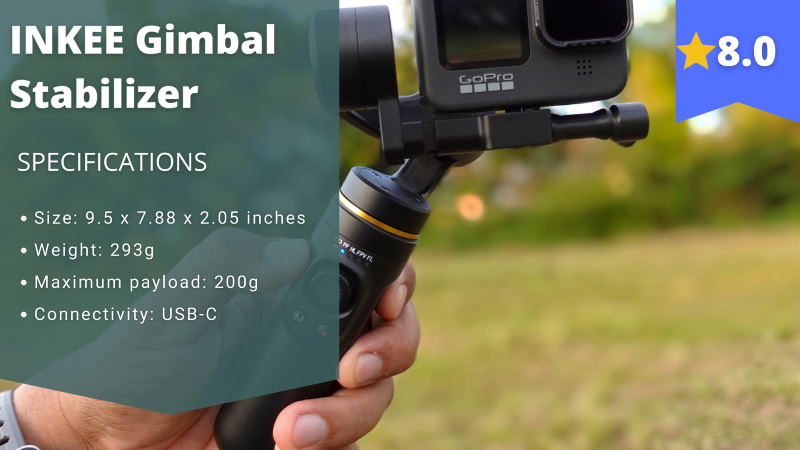
Stefan’s Take:
Initially, I got this gimbal for my DSLR, but it worked best with GoPro and smaller action cameras. I wasn’t too sure about the handheld feature, but it’s lightweight and won’t cause any discomfort.
The tripod is easy to assemble and attach, so that you can get great shots in this way too. Moreover, the battery life is also great, but you’re limited by its size.
| Payload | 8 |
|---|---|
| Number of Axis | 8 |
| Remote Control | 8 |
| Battery Life | 8 |
This compact gimbal stabilizer is specifically designed for action cameras and has been modified in various ways compared to standard gimbals.
Weighing only 393 grams, it is extremely lightweight, making it easy to use as a handheld gimbal. It also includes an extension tripod, allowing you to place it on the ground when needed.
Another great feature of this gimbal is its support for several shooting modes, including some that are rarely found in handheld gimbal stabilizers, such as vertical and low-angle shooting modes.
Similarly, the automatic response of the three motors that move and reposition the camera is quite fast; however, it unfortunately does not allow for remote control, which I consider a downside.
As an action camera stabilizer, this gimbal has a limited carrying capacity of approximately 200g. This renders it unsuitable for most DSLR cameras; however, it can effectively serve as a dedicated smartphone gimbal, which some users may find quite beneficial.
Finally, it boasts a respectable battery life of up to 9 hours and can be conveniently recharged through a USB-C connection. However, it is important to note that the initial charging should not be interrupted until the battery is fully charged, as this enables it to achieve its maximum capacity for future use.
Overall, this is undoubtedly the best gimbal on this list for small cameras and handheld footage, enabling you to effortlessly capture shots while on the move. If you mainly use small cameras and smartphones for your footage, this is an outstanding choice. Otherwise, consider a larger gimbal.
Pros
- Perfect for capturing handheld footage on the move
- Very easy to recharge
- Includes an extension rod and a tripod
Cons
- Small size and carry capacity
What to Look for in the Best Gimbal for DSLR
Payload Capacity
In simple terms, having adequate payload capacity is crucial for determining if a specific gimbal can be used with your camera. Therefore, the first thing you should verify before making a purchase is whether it can support the weight of your camera.
Number of Axes
Having more axes available when adjusting your camera’s position enables you to create clearer and more stable footage. Furthermore, it allows you to achieve angles that would otherwise be impossible to manage.
Motors and Remote Control
Motors and remote control significantly enhance the versatility of your gimbal. Motors enable the automation of movements, increasing precision and allowing you to concentrate on other tasks. Meanwhile, remote control allows you to operate your gimbal from a distance, both of which are highly beneficial in various situations.
Conclusion
We have reached the conclusion of this guide. I hope you found my reviews helpful and that you selected a suitable gimbal.
If you are still uncertain, take a look at my top three selections once again:
Ultimately, it depends on your needs. I’m confident you won’t be disappointed with whichever option you select from the list. Happy streaming and vlogging!
FAQ
Which gimbal is best for a camera?
There is no singular answer to this question. Instead, your choice will depend on what size and type of camera you are using, as well as the type of footage you are using it for. Regardless of your preferences, you can find a good DSLR gimbal for yourself in this guide.
What is a good DSLR gimbal?
There are quite a few competitors for this elusive top spot, each of them featuring pros and cons in regards to each other. This means you should look for specifications instead of simply looking for a specific product. Luckily for you, this list contains a detailed explanation of some of the most useful and versatile DSLR gimbals on the market, complete with our testing results.
Is a gimbal worth it for a DSLR?
Definitely. Owning a gimbal will make your camera movements much more precise and, in some cases, even allow for remote control. Additionally, there are gimbals that can be used to recharge your camera from its own battery, some of which can be found on this list.






